HP Takes on Apple with the New Voodoo
by Anand Lal Shimpi on June 11, 2008 12:00 AM EST- Posted in
- Systems
The Most Mac-Like PC Notebook Ever Made: The Envy 133
First, the most interesting one, the Voodoo Envy 133:
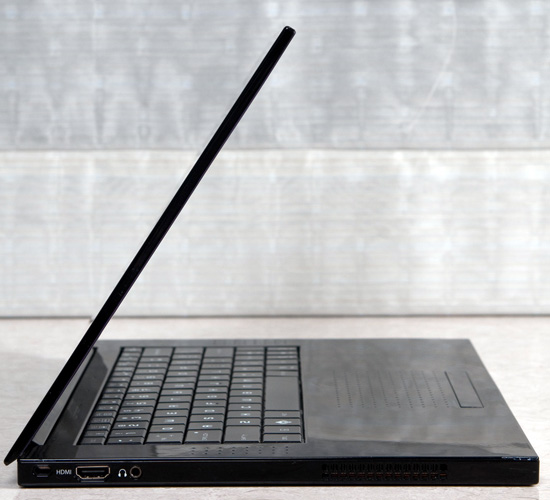
Built on an all carbon-fiber chassis (Rahul Sood, founder of Voodoo, is a car nut) the Envy 133 is the closest thing we've seen to an Apple-designed notebook that didn't have fruit on its lid.
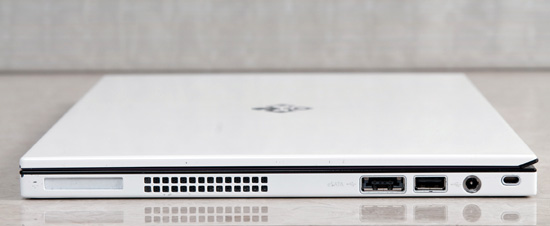
HP will say that it's thinner than the MacBook Air, but that's only true at the Air's thickest point. The Envy 133 is a constant 0.70" thick whereas the MacBook Air goes from 0.16" at its thinnest point to 0.76" at its thickest. Arguing about thickness is entirely missing the point, the new Envy is a very cleanly designed machine with a constant thickness, clean lines and very elegant design. Honestly, the only detractor from its elegance is the Voodoo logo which is still a bit more gamer and less "lifestyle PC".
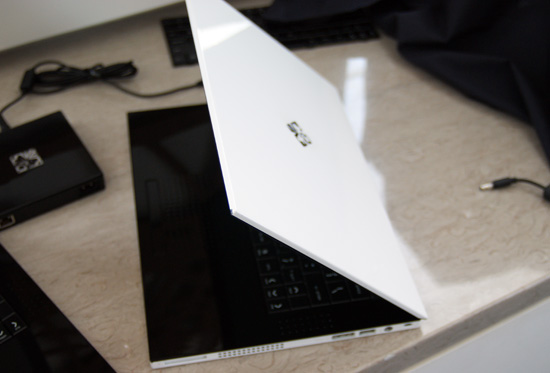
The internals are virtually identical to the MacBook Air; it uses the same 1.8" 4200RPM PATA HDD (a 64GB SSD is optional, just like on the Air) and there is no internal optical drive (the system ships with an external eSATA DVDRW drive). The Envy also uses the same CPU as the MacBook Air - a 1.6GHz or 1.8GHz Merom based Core 2 Duo built on a smaller package.
Also like the MacBook Air, the Envy lacks a built in Ethernet port - but here's one area where Voodoo actually out-innovated Apple: the Ethernet port is built into the power brick. If you have the power adapter plugged in, you can plug in an Ethernet cable into a port on the brick and it will communicate wirelessly with the Envy; the power adapter acts as a wireless access point. You can't use the wired Ethernet and the built in 802.11a/g/n at the same time since the integrated wireless is used to communicate with the external Ethernet, but in most cases you wouldn't want to. Voodoo tells us that the efficiency of the external 10/100 Ethernet is around 80 - 85% over wireless, which is about right given normal OS and network stack overhead.

There's a LED backlit keyboard and integrated webcam like the Air, but Voodoo goes on to add an ExpressCard 34 slot and a HDMI output. There's obviously an eSATA port but it's actually powered via USB.
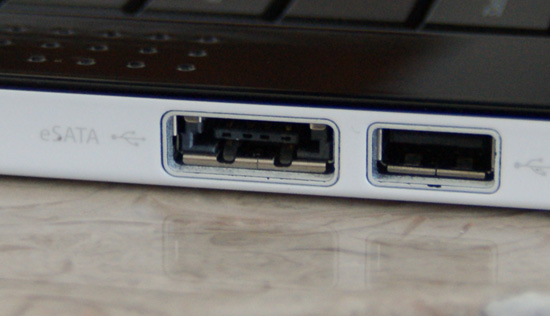
The 13.3" screen is LED backlit and has the same 1280 x 800 resolution as the panel in the MacBook Air and Voodoo also built in an ambient light sensor, presumably to control the brightness of the display and keyboard.
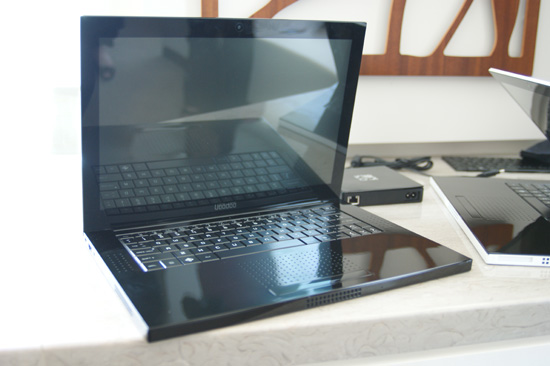
The battery is removable but it is a lower power unit than what is in the Air (33Whr vs. 37Whr), so battery life should actually be lower than what you'd get on a MacBook Air.
The feature list is damn impressive, not only was Voodoo able to virtually clone the MacBook Air but there are also improvements. On paper, it's the most impressive notebook design we've seen from a Windows-PC vendor.
Priced at $2099 with a PATA drive, it's a bit more expensive than the MacBook Air. It ships with a custom Voodoo version of the Splashtop pre-boot OS similar to the ASUS Eee Box or some ASUS motherboards. Availability is scheduled for later this summer.
















56 Comments
View All Comments
michael2k - Thursday, June 12, 2008 - link
Were you a Mac user that bought the first Intel Macs?The software was at worst 2x slower.
And... you say, "They are being held back by inferior industrial design", which is exactly what was written in the intro for this article. The only reason Vista was mentioned was because that was an aspect of PC design the OEMs had precious control over, so the only thing left for them to tackle was industrial design.
You think you are superior for not "succumbing" to pro-Mac sentiment? Is that like not "succumbing" to pro-Zune sentiment, or pro-XBox sentiment, or any other "underdog gaining in popularity" sentiment?
Steve Guilliot - Saturday, June 14, 2008 - link
Yes, I bought one of the first Intel Mac Minis, and I had to upgrade the RAM to 2GB because of Rosetta. I have some experience here, thanks.So I'm wrong becuase the speed hit from Rosetta was 2x instead of 5x. Don't you know you're making my point? Anandtech articles frequently make much of a 3% speed increase due to faster RAM, etc. Don't you think a 50% performance hit is significant?
Second, if you only percieve a 2x slowdown, it's because the Intel hardware was fundamentally faster masking much of the slowdown. You can't seriously say the speed improvement from Photoshop CS2 to CS3 was only 2x.
I notice you ignored my point about poor app stability. I've had apps crash in Rosetta far more frequently than Vista pre-SP1 (which is to say almost never).
It doesn't matter that the article mentioned the inferior industrial design when they go on to put blame on MS. Maybe the only thing the OEMs could tackle was industrial design. So? They still failed at that, didn't they?
I own a 5G iPod, a Zune, an Intel Mac, and a few PCs. I do see both sides, and I can say with certiantly that the pro-Mac position is hyped, and MS is getting shorted by the tech community who think it's cool to blast Windows.
Inkjammer - Thursday, June 12, 2008 - link
Yep, I concur. I've been playing around with Vista since launch day and I've only had one app (out of dozens and dozens) that wouldn't work right. Short of some driver issues (Creative and Nvidia) I never had any real Vista-specific issues.On my old Toshiba Tecra M7, Vista BSOD'd the first time I loaded it up. When I rebooted, Vista gave me a warning messaged that it detected the crash was caused by an incompatible BIOS and that a new BIOS was available for download, even provided a link as to where to get the update. Never had a problem after flashing my system. I was rather impressed with that.
ElFindo - Thursday, June 12, 2008 - link
It seems to me that I had more trouble getting things running under XP out of the box. When there was that initial shift and everything was 'compatibility mode', which didn't work half the time anyways. In fact some of those same programs I had issues running under XP (mostly games in my experience) actually did run on Vista out of the box.Rev1 - Wednesday, June 11, 2008 - link
I'll agree there with you on that, when i 1st got my comp last year at vista launch most of my probs with it not working right was vista, and a cheap nzxt 500w power suply which was purely my fault. Having said that though i think vista works fine now exept no Hd acceleration for sounds cards like eax. I thought my logitech z5300 on a audigy 2zs on xp sounded light years better than my current z5500 on a X-fi extreme gamer on vista. So bad actually i switch to the onboard realtek and use the optical connection for sound.adelaidewright - Friday, February 11, 2011 - link
Definitely, Windows 7 is about to impresses the XP users who resisted to Vista on the ground of performance and compatibility. Windows' newest avatar has a great look and it consumes least of the system resources. It's not surprising that more and more users are migrating to Windows 7. Windows 7 is a multi talented Operating System which includes native functionality to read and write Blue-Ray discs. Windows 7 has many built-in tools to help with program compatibility and it also features an improved backup solution to help keep your information safe. Windows7 is an advanced Operating System with excellent features. Windows 7 builds on the substantial investment.The Window Support is an independent provider of on-demand tech support and not affiliated with any third party brand unless specified. Their service was very professional and resolved my problem completely. As always were very patience and knowledgeable. They managed to solve the problem.
http://www.thewindowssupport.com